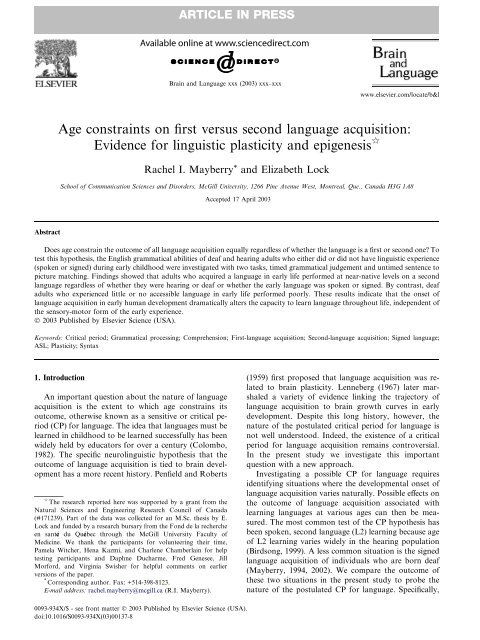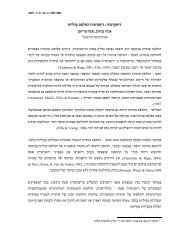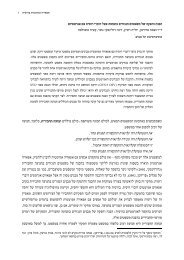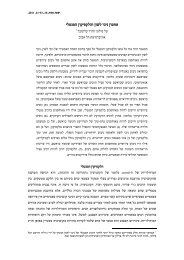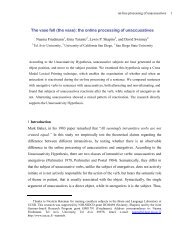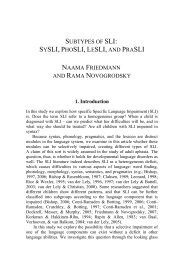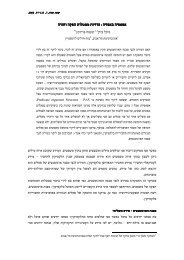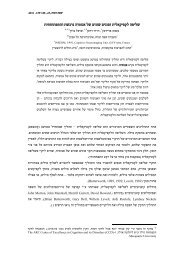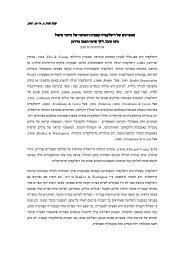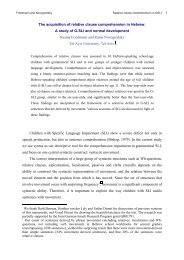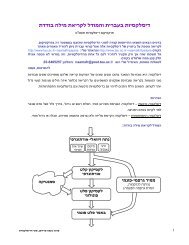Age constraints on first versus second language acquisition ...
Age constraints on first versus second language acquisition ...
Age constraints on first versus second language acquisition ...
- No tags were found...
Create successful ePaper yourself
Turn your PDF publications into a flip-book with our unique Google optimized e-Paper software.
ARTICLE IN PRESSBrain and Language xxx (2003) xxx–xxxwww.elsevier.com/locate/b&l<str<strong>on</strong>g>Age</str<strong>on</strong>g> <str<strong>on</strong>g>c<strong>on</strong>straints</str<strong>on</strong>g> <strong>on</strong> <strong>first</strong> <strong>versus</strong> sec<strong>on</strong>d <strong>language</strong> acquisiti<strong>on</strong>:Evidence for linguistic plasticity and epigenesis qRachel I. Mayberry * and Elizabeth LockSchool of Communicati<strong>on</strong> Sciences and Disorders, McGill University, 1266 Pine Avenue West, M<strong>on</strong>treal, Que., Canada H3G 1A8Accepted 17 April 2003AbstractDoes age c<strong>on</strong>strain the outcome of all <strong>language</strong> acquisiti<strong>on</strong> equally regardless of whether the <strong>language</strong> is a <strong>first</strong> or sec<strong>on</strong>d <strong>on</strong>e? Totest this hypothesis, the English grammatical abilities of deaf and hearing adults who either did or did not have linguistic experience(spoken or signed) during early childhood were investigated with two tasks, timed grammatical judgement and untimed sentence topicture matching. Findings showed that adults who acquired a <strong>language</strong> in early life performed at near-native levels <strong>on</strong> a sec<strong>on</strong>d<strong>language</strong> regardless of whether they were hearing or deaf or whether the early <strong>language</strong> was spoken or signed. By c<strong>on</strong>trast, deafadults who experienced little or no accessible <strong>language</strong> in early life performed poorly. These results indicate that the <strong>on</strong>set of<strong>language</strong> acquisiti<strong>on</strong> in early human development dramatically alters the capacity to learn <strong>language</strong> throughout life, independent ofthe sensory-motor form of the early experience.Ó 2003 Published by Elsevier Science (USA).Keywords: Critical period; Grammatical processing; Comprehensi<strong>on</strong>; First-<strong>language</strong> acquisiti<strong>on</strong>; Sec<strong>on</strong>d-<strong>language</strong> acquisiti<strong>on</strong>; Signed <strong>language</strong>;ASL; Plasticity; Syntax1. Introducti<strong>on</strong>An important questi<strong>on</strong> about the nature of <strong>language</strong>acquisiti<strong>on</strong> is the extent to which age c<strong>on</strong>strains itsoutcome, otherwise known as a sensitive or critical period(CP) for <strong>language</strong>. The idea that <strong>language</strong>s must belearned in childhood to be learned successfully has beenwidely held by educators for over a century (Colombo,1982). The specific neurolinguistic hypothesis that theoutcome of <strong>language</strong> acquisiti<strong>on</strong> is tied to brain developmenthas a more recent history. Penfield and Robertsq The research reported here was supported by a grant from theNatural Sciences and Engineering Research Council of Canada(#171239). Part of the data was collected for an M.Sc. thesis by E.Lock and funded by a research bursary from the F<strong>on</strong>d de la rechercheen sante du Quebec through the McGill University Faculty ofMedicine. We thank the participants for volunteering their time,Pamela Witcher, Hena Kazmi, and Charlene Chamberlain for helptesting participants and Daphne Ducharme, Fred Genesee, JillMorford, and Virginia Swisher for helpful comments <strong>on</strong> earlierversi<strong>on</strong>s of the paper.* Corresp<strong>on</strong>ding author. Fax: +514-398-8123.E-mail address: rachel.mayberry@mcgill.ca (R.I. Mayberry).(1959) <strong>first</strong> proposed that <strong>language</strong> acquisiti<strong>on</strong> was relatedto brain plasticity. Lenneberg (1967) later marshaleda variety of evidence linking the trajectory of<strong>language</strong> acquisiti<strong>on</strong> to brain growth curves in earlydevelopment. Despite this l<strong>on</strong>g history, however, thenature of the postulated critical period for <strong>language</strong> isnot well understood. Indeed, the existence of a criticalperiod for <strong>language</strong> acquisiti<strong>on</strong> remains c<strong>on</strong>troversial.In the present study we investigate this importantquesti<strong>on</strong> with a new approach.Investigating a possible CP for <strong>language</strong> requiresidentifying situati<strong>on</strong>s where the developmental <strong>on</strong>set of<strong>language</strong> acquisiti<strong>on</strong> varies naturally. Possible effects <strong>on</strong>the outcome of <strong>language</strong> acquisiti<strong>on</strong> associated withlearning <strong>language</strong>s at various ages can then be measured.The most comm<strong>on</strong> test of the CP hypothesis hasbeen spoken, sec<strong>on</strong>d <strong>language</strong> (L2) learning because ageof L2 learning varies widely in the hearing populati<strong>on</strong>(Birds<strong>on</strong>g, 1999). A less comm<strong>on</strong> situati<strong>on</strong> is the signed<strong>language</strong> acquisiti<strong>on</strong> of individuals who are born deaf(Mayberry, 1994, 2002). We compare the outcome ofthese two situati<strong>on</strong>s in the present study to probe thenature of the postulated CP for <strong>language</strong>. Specifically,0093-934X/$ - see fr<strong>on</strong>t matter Ó 2003 Published by Elsevier Science (USA).doi:10.1016/S0093-934X(03)00137-8
ARTICLE IN PRESS2 R.I. Mayberry, E. Lock / Brain and Language xxx (2003) xxx–xxxwe ask whether the <strong>on</strong>set of <strong>language</strong> acquisiti<strong>on</strong> inearly life is related to the subsequent ability to learn anyother <strong>language</strong> for the remainder of life, independent ofthe sensory and motor modalities of the <strong>first</strong> or sec<strong>on</strong>d<strong>language</strong>s. Positive evidence of this kind would suggestthat the postulated CP for <strong>language</strong> is similar to otherbiological phenomena whereby early experience organizesthe development of a genetically specified systemand its neural underpinnings in an epigenetic fashi<strong>on</strong>(Changeux, 1985) as we explain below. Before describingthe present study, we turn to previous research <strong>on</strong>age of acquisiti<strong>on</strong> effects <strong>on</strong> the grammatical outcome of<strong>language</strong> acquisiti<strong>on</strong> beginning with the case of signed<strong>language</strong>, followed by spoken <strong>language</strong>.Several studies have investigated age of acquisiti<strong>on</strong>effects <strong>on</strong> the outcome of American sign <strong>language</strong>(ASL). ASL is the most comm<strong>on</strong>ly used signed <strong>language</strong>in North America but <strong>on</strong>ly <strong>on</strong>e of the worldÕs manysigned <strong>language</strong>s (Klima & Bellugi, 1979). Signed <strong>language</strong>sare natural <strong>language</strong>s that have evolved throughgenerati<strong>on</strong>s of childrenÕs acquisiti<strong>on</strong> and adult use byDeaf communities worldwide (Baynt<strong>on</strong>, 1996; Senghas& Coppola, 2001). Because they are natural <strong>language</strong>sindependent of spoken <strong>language</strong>s, signed <strong>language</strong>s areneither universal nor gesture codes for speech (Morford& Kegl, 2000). The linguistic architecture of signed<strong>language</strong> is similar to that of spoken <strong>language</strong> in that itis characterized by rule-bound form at the levels ofph<strong>on</strong>ology, morphology and syntax, and semantics (fora review see Emmorey, 2002). Infants exposed to ASLby their parents acquire it in a fashi<strong>on</strong> and <strong>on</strong> a timetableakin to hearing childrenÕs acquisiti<strong>on</strong> of spoken<strong>language</strong>s (Chamberlain, Morford, & Mayberry, 2000;Lillo-Martin, 1999; Petitto & Marentette, 1991).In the <strong>first</strong> study of age <str<strong>on</strong>g>c<strong>on</strong>straints</str<strong>on</strong>g> <strong>on</strong> ultimate attainmentin ASL, Mayberry and Fischer (1989) foundsignificant differences in the narrative shadowing performanceand lexical error patterns of native signers(who learned ASL from their deaf parents) compared tothat of n<strong>on</strong>-native signers (who learned ASL betweenthe ages of 9 and 16). In a sec<strong>on</strong>d experiment, performanceaccuracy <strong>on</strong> ASL sentence shadowing and recalltasks showed a linear relati<strong>on</strong> to age of acquisiti<strong>on</strong>(between the ages of birth to 15 years), when length ofASL experience was a c<strong>on</strong>founding factor. In a thirdexperiment c<strong>on</strong>trolling length of experience, age of acquisiti<strong>on</strong>c<strong>on</strong>tinued to show a significant linear relati<strong>on</strong>to performance accuracy and morphological error patterns<strong>on</strong> a task of complex ASL sentence recall (Mayberry& Eichen, 1991). Newport (1990) also found ageof acquisiti<strong>on</strong> (from birth to older than 13 years) tocorrelate with ASL ultimate attainment using a compositescore derived from a battery of expressive andreceptive ASL tests. Finally, Emmorey, Bellugi, Friederici,and Horn (1995) found native ASL learners tooutperform n<strong>on</strong>-native learners <strong>on</strong> a sign m<strong>on</strong>itoringtask but not <strong>on</strong> a grammatical judgement task. Togetherthese results indicate that age of acquisiti<strong>on</strong> is an importantfactor in the outcome of signed <strong>language</strong> acquisiti<strong>on</strong>.Clearly age <str<strong>on</strong>g>c<strong>on</strong>straints</str<strong>on</strong>g> <strong>on</strong> <strong>language</strong>acquisiti<strong>on</strong> are not limited to spoken <strong>language</strong>s to whichwe now turn.The most comm<strong>on</strong> method of investigating age <str<strong>on</strong>g>c<strong>on</strong>straints</str<strong>on</strong>g><strong>on</strong> the outcome of <strong>language</strong> acquisiti<strong>on</strong> has beento measure the grammatical ability of individuals wholearned a sec<strong>on</strong>d spoken <strong>language</strong> at varying ages. Somestudies have investigated age <str<strong>on</strong>g>c<strong>on</strong>straints</str<strong>on</strong>g> <strong>on</strong> the outcomeof L2 ph<strong>on</strong>ological learning but, because the focus ofthe present study is grammatical ability, we do not discussthem here (see Flege, 1999). Several studies reporteda negative correlati<strong>on</strong> between age of spoken L2acquisiti<strong>on</strong> and L2 grammatical outcome and/or significantdifferences in grammatical performance betweennative and n<strong>on</strong>-native learners. These effects were foundusing a variety of <strong>language</strong> measures including: sentenceshadowing (Oyama, 1978), assessment of written transcriptsof spoken interviews (Patkowski, 1980), and assessmentof tape-recorded interviews (White & Genesee,1996). Other studies reported effects for age of acquisiti<strong>on</strong><strong>on</strong> L2 grammatical outcome using judgement ofgrammatical and ungrammatical sentences presented ineither auditory or written forms (Birds<strong>on</strong>g, 1992; Birds<strong>on</strong>g& Molis, 2001; Flege, Yeni-Komshian, & Liu,1999; Johns<strong>on</strong> & Newport, 1991; Johns<strong>on</strong>, 1992; White& Genesee, 1996). In most studies the L2 tested wasEnglish; French was the L2 in <strong>on</strong>e study (Birds<strong>on</strong>g,1992). The <strong>first</strong> <strong>language</strong>s (L1) were Chinese, French,Italian, Korean, Spanish, or unspecified. 1Although a negative correlati<strong>on</strong> between age of L2acquisiti<strong>on</strong> and grammatical outcome has been replicatedseveral times using a variety of <strong>language</strong> measuresacross a variety of <strong>first</strong> <strong>language</strong>s, c<strong>on</strong>troversy remainsas to whether these findings provide positive evidencefor the postulated CP for <strong>language</strong>. Most studies foundL2 grammatical outcome to show a linear functi<strong>on</strong> inrelati<strong>on</strong> to age of acquisiti<strong>on</strong>; as age of acquisiti<strong>on</strong> increases,L2 grammatical outcome decreases after the ageof 8 (e.g., Birds<strong>on</strong>g & Molis, 2001; Flege et al., 1999;Johns<strong>on</strong> & Newport, 1989; Oyama, 1978; Patkowski,1980). However, some researchers have argued that theslope of the functi<strong>on</strong> between age of acquisiti<strong>on</strong> andgrammatical outcome should be n<strong>on</strong>-linear in natureand stop abruptly at some age coincident with the end ofthe CP (e.g., Bialystok & Hakuta, 1999).A n<strong>on</strong>-linear functi<strong>on</strong> between age of L2 acquisiti<strong>on</strong>and grammatical outcome was found by Johns<strong>on</strong> andNewport (1989), who tested native speakers of Chineseand Korean with an untimed, grammatical judgement1 Several studies claiming age of acquisiti<strong>on</strong> effects for L2 outcomeare not cited here because they either did not c<strong>on</strong>trol for practice effectsor perform the necessary statistical tests.
ARTICLE IN PRESSR.I. Mayberry, E. Lock / Brain and Language xxx (2003) xxx–xxx 3task presented auditorally (with a written resp<strong>on</strong>se) usinga variety of English grammatical structures. <str<strong>on</strong>g>Age</str<strong>on</strong>g> ofL2 acquisiti<strong>on</strong> correlated with grammatical judgementscores between the ages of 3 and 15 (r ¼ :87) but notbetween the ages of 17 and 39 (r ¼ :16). These findingswere interpreted to mean that the ability to acquire any<strong>language</strong>, <strong>first</strong> or sec<strong>on</strong>d, disappears with increasingmaturati<strong>on</strong>. Two subsequent studies failed to replicatethis n<strong>on</strong>-linear functi<strong>on</strong> between age of L2 acquisiti<strong>on</strong>and grammatical outcome, however.First, Flege et al. (1999) tested Korean learners ofEnglish with procedures similar to those used by Johns<strong>on</strong>and Newport (1989). Pre-puberty ages of acquisiti<strong>on</strong>correlated with grammatical outcome (3–12 years,r ¼ :52) but, importantly, post-puberty ages also correlatedwith grammatical outcome (13–21 years,r ¼ :27). In another study, Birds<strong>on</strong>g and Molis (2001)used the same methods and English stimuli as Johns<strong>on</strong>and Newport (1989) but with native Spanish speakers.<str<strong>on</strong>g>Age</str<strong>on</strong>g> of L2 acquisiti<strong>on</strong> did not correlate with grammaticaloutcome between the ages of 3 and 15. This wasprimarily due to ceiling effects; many L2 learners performedwithin the range of the native English speakers.Moreover, age of L2 acquisiti<strong>on</strong> correlated with grammaticaloutcome at ages well bey<strong>on</strong>d childhood, specifically,between the ages of 17 and 44 ðr ¼ :69Þ,corroborating the findings of Flege et al. (1999). Thesefindings are counter to the maturati<strong>on</strong> hypothesis.The results of studies investigating the relati<strong>on</strong> betweenage of acquisiti<strong>on</strong> and L2 grammatical outcomeare thus inc<strong>on</strong>clusive with respect to the existence of aCP for <strong>language</strong> acquisiti<strong>on</strong>. Declines in L2 grammaticalperformance associated with increasing age of L2 acquisiti<strong>on</strong>after age 8 have been reported in severalstudies. However, studies have also found that the declinein L2 grammatical performance associated withincreasing age of L2 acquisiti<strong>on</strong> does not appear to stopat any age after maturati<strong>on</strong>. An important factor in theL2 situati<strong>on</strong> with respect to a possible CP for <strong>language</strong> isthat it entails, by definiti<strong>on</strong>, prior acquisiti<strong>on</strong> of an L1 inearly life. Some researchers have proposed that thescope of the CP for <strong>language</strong> is restricted to L1 outcome,citing as evidence the few available case studies of socialisolati<strong>on</strong> in early childhood (e.g., Eubank & Gregg,1999, am<strong>on</strong>g others). Cases of childhood social isolati<strong>on</strong>are difficult to interpret given the multiple additi<strong>on</strong>aldeprivati<strong>on</strong>s often suffered by these children (Curtiss,1977). Whether the postulated CP for <strong>language</strong> primarilyaffects L1 outcome as compared to L2 outcome isan empirical questi<strong>on</strong> with theoretically significantramificati<strong>on</strong>s. We investigated this questi<strong>on</strong> in previousresearch (Mayberry, 1993, 1994). The goal of the presentstudy was to replicate and extend these findings.One naturally occurring situati<strong>on</strong> where age of L1acquisiti<strong>on</strong> varies naturally and widely is the signed<strong>language</strong> acquisiti<strong>on</strong> of individuals who are born deaf(Mayberry, 1994, 2002; Morford & Mayberry, 2000).Babies who hear normally are exposed to spoken <strong>language</strong>from birth nearly without excepti<strong>on</strong>. By c<strong>on</strong>trast,infants who are born severely and profoundly deaf areisolated from the <strong>language</strong> spoken around them byvirtue of their deafness. Except in a minority of caseswhere the parents use ASL (i.e.,
ARTICLE IN PRESS4 R.I. Mayberry, E. Lock / Brain and Language xxx (2003) xxx–xxxwho learned English at similar ages but who had threec<strong>on</strong>trasting types of <strong>language</strong> experience in early childhood:(a) early acquisiti<strong>on</strong> of a spoken <strong>language</strong> frombirth; (b) early acquisiti<strong>on</strong> of a signed <strong>language</strong> frombirth; and (c) little or no <strong>language</strong> acquisiti<strong>on</strong> duringearly childhood. Finding superior grammatical performanceby the early <strong>language</strong> learners compared to thelearners who experienced sparse early <strong>language</strong> wouldsupport the hypothesis that accessible <strong>language</strong> inputduring human development is necessary for the capacityto learn <strong>language</strong> to develop fully. By c<strong>on</strong>trast, findingsimilar grammatical performance by the learners withand without early <strong>language</strong> experience would providecounter-evidence to our hypothesis and suggest insteadthat maturati<strong>on</strong> al<strong>on</strong>e underlies age <str<strong>on</strong>g>c<strong>on</strong>straints</str<strong>on</strong>g> <strong>on</strong> thecapacity to learn <strong>language</strong>. Finally, finding no performancedifferences between the hearing and deaf early<strong>language</strong> learners, whose <strong>first</strong> <strong>language</strong>s were spokenand signed, respectively, would mean that developmentof the <strong>language</strong> learning capacity is plastic withrespect to the sensory and motor form of the earlyexperience and hence not a factor in the criticalperiod phenomen<strong>on</strong>.2. Methods2.1. ParticipantsFifty-four adults with c<strong>on</strong>trasting types of <strong>language</strong>experience in early life were recruited into the studyfrom four Canadian cities and placed in four groups.Two groups were normally hearing and two groups wereprofoundly deaf. The groups c<strong>on</strong>sisted of approximatelyequal numbers of men and women with the <strong>language</strong>backgrounds described below and shown in Table 1.2.1.1. Native English c<strong>on</strong>trolsFourteen individuals who had normal hearingthroughout life and were native speakers of Englishserved as c<strong>on</strong>trols (henceforth native c<strong>on</strong>trols, NC).English was their native <strong>language</strong> which they used sociallyand at home, work, and school. All but <strong>on</strong>e NCparticipant later received sec<strong>on</strong>d-<strong>language</strong> instructi<strong>on</strong> inelementary school, French in all cases. The eight menand six women had a mean age of 26.43 years with arange of 16–46 years.2.1.2. Early signed <strong>language</strong>Fourteen participants were born profoundly deaf andacquired ASL as a <strong>first</strong> <strong>language</strong> in early life (henceforthEarly-Sign Lang). ASL was the maternal <strong>language</strong> of 11Early-Sign Lang participants whose deaf parents used itwith them from birth. Two participants had older deafsiblings who communicated with them in signed <strong>language</strong>prior to age three; <strong>on</strong>e participant had normallyhearing parents who learned and used signed <strong>language</strong>before the age of three. The Early-Sign Lang participantswere later exposed to English as a sec<strong>on</strong>d <strong>language</strong>when they enrolled in preschools and elementary schoolswhere English was the <strong>language</strong> of instructi<strong>on</strong> betweenthe ages of 3 and 7 years.The Early-Sign Lang participants were primarilytaught English through a combinati<strong>on</strong> of signs andspoken English, in additi<strong>on</strong> to lipreading, reading, andwriting. The classroom <strong>language</strong> of instructi<strong>on</strong> for theEarly-Sign Lang participants was English, primarily inthe form of simultaneously spoken English and signedManually Coded English (MCE). 2 These participantsreported that most of their hearing teachers spoke andsimultaneously signed MCE but that a few deaf teachersused ASL.The length of time the Early-Sign Lang participantshad used English was computed by subtracting age ofschool enrollment from chr<strong>on</strong>ological age. Mean lengthof English use was 24.5 years with a range of 14–47years. The eight men and six women ranged in age from17 to 52 years with a mean of 25.5 years.2.1.3. Early spoken <strong>language</strong>Thirteen participants had normal hearing throughoutlife and acquired a spoken <strong>language</strong> other than Englishfrom birth; they later learned English as a sec<strong>on</strong>d <strong>language</strong>after enrolling in a school where English was the<strong>language</strong> of instructi<strong>on</strong> (henceforth Early-Spkn Lang).Urdu was the maternal <strong>language</strong> of eight Early-SpknLang participants; French was the maternal <strong>language</strong> oftwo participants; and German, Italian, and Greek werethe maternal <strong>language</strong>s of three participants respectively.The Early-Spkn Lang participants began to learnEnglish as a sec<strong>on</strong>d <strong>language</strong> in schools where Englishwas the <strong>language</strong> of instructi<strong>on</strong> between the ages of 6and 13 years with a mean age of 9 years. After enrollingin an English school, all the Early-Spkn Lang participantsc<strong>on</strong>tinued to use their maternal <strong>language</strong> at homeand socially with friends. The Early-Spkn Lang participantshad used English as an L2 for a mean of 23.46years with a range of 12–50 years. The seven men and sixwomen ranged in age from 17 to 57 with a mean age of32.46 years.2 Pedagogical sign systems designed to teach English to deafchildren go by a variety of names in North America, such as ManuallyCoded English (MCE) or signed English. Open class signs areborrowed from a natural signed <strong>language</strong>, ASL in this case, andproduced in English word order al<strong>on</strong>g with invented signs for porti<strong>on</strong>sof English grammatical morphology. Using this communicati<strong>on</strong>method, known as Total Communicati<strong>on</strong> or TC, the teacher speaksEnglish and simultaneously produces the signs of MCE. The grammaticalstructure of MCE is very different from that of ASL (seeSchick & Moeller, 1992).
ARTICLE IN PRESSR.I. Mayberry, E. Lock / Brain and Language xxx (2003) xxx–xxx 5Table 1Background characteristics of the experimental groupsEarly <strong>language</strong> experience n Females/MalesMean age of Englishexposure (range)Mean years of Englishuse (range)Mean chr<strong>on</strong>ologicalage (range)Early-Spkn English (native c<strong>on</strong>trol) 14 6/8 Birth (0) 26.43 (16–46) 26.43 (16–46)Early-Sign Lang (not English) 14 8/6 5.0 (4–7) 24.5 (14–47) 25.5 (17–52)Early-Spoken Lang (not English) 13 6/7 9.00 (6–13) 23.46 (12–50) 32.46 (17–57)No-Early Lang 13 8/6 9.40 (6–13) 26 (11–64) 35.23 (23–70)2.1.4. No early <strong>language</strong>Thirteen participants were born profoundly deaf andhad normally hearing parents and siblings. Due to theirdeafness, however, the English spoken by their familieswas inaccessible to them in infancy and early childhood.In additi<strong>on</strong>, their families neither knew nor used anyform of signed <strong>language</strong> with them throughout earlychildhood. Twelve participants <strong>first</strong> attended preschoolsfor deaf children where child/teacher interacti<strong>on</strong> wasrestricted to speech (with no signs of any kind used)between the ages of 3 and 6 with a mean age of 4.1.However, due to a lack of speech development due totheir profound deafness as described below (lipreadingal<strong>on</strong>e provides insufficient linguistic input for spoken<strong>language</strong> to develop sp<strong>on</strong>taneously), they were subsequentlyswitched to schools where sign was used, betweenthe ages of 6 and 13 with a mean age of 9.4. Thisis a comm<strong>on</strong> educati<strong>on</strong>al occurrence arising from thepriority frequently given to speech over sign by rehabilitati<strong>on</strong>professi<strong>on</strong>als and hearing parents. One participantattended no preschool and <strong>first</strong> enrolled in aschool where sign was used at age 7. All these participantsc<strong>on</strong>sequently had little accessible <strong>language</strong> exposureuntil age 6 or older (henceforth No-Early Lang).After enrolling in a school where sign was used, the No-Early Lang participants were taught English in the samemanner as the Early-Sign Lang participants, primarilythrough a combinati<strong>on</strong> of signs and spoken English (seeEndnote 2). They were also taught English through lipreading,reading, and writing. Several of these participantsattended the same schools as the Early-Sign Langparticipants. The eight men and six women ranged in agefrom 23 to 70 with a mean age of 35.23 years. The meanlength of time the No-Early Lang participants had usedEnglish was 26 years with a range of 11–64 years.2.2. Group comparabilityEducati<strong>on</strong>al background was c<strong>on</strong>trolled across thegroups; all participants had completed high school butn<strong>on</strong>e had completed college. The following additi<strong>on</strong>alfactors were also c<strong>on</strong>trolled.2.2.1. <str<strong>on</strong>g>Age</str<strong>on</strong>g> of English exposure<str<strong>on</strong>g>Age</str<strong>on</strong>g> of accessible English exposure was matched asclosely as possible for the Early-Spkn Lang and No-Early Lang participants and c<strong>on</strong>sidered to be the age of<strong>first</strong> enrollment in a school where the <strong>language</strong> of instructi<strong>on</strong>was English, spoken English for the formergroup and MCE and simultaneously spoken English forthe latter group. Approximately half the participants ineach group were <strong>first</strong> exposed to accessible English betweenthe ages of 6 and 8 years (Early-Spkn Lang group,n ¼ 8; No- Early Lang group, n ¼ 6); the remainingparticipants in each group were <strong>first</strong> exposed to Englishbetween the ages of 9 and 13 years (Early- Spkn Lang,n ¼ 6; No-Early Lang, n ¼ 7). There was no differencein age of <strong>first</strong> accessible English exposure between thetwo groups (t ¼ 1:047; df ¼ 24, ns). In additi<strong>on</strong>, therewas an overlap in the age of exposure to accessibleEnglish between the above groups and the Early-Signgroup; six Early-Sign participants were <strong>first</strong> exposed toaccessible English between the ages of 4 and 7 years; theremaining eight participants were <strong>first</strong> exposed at age 3.2.2.2. Length of English useTo ensure that each participant had a baselineamount of English experience, defined as years of use,<strong>on</strong>ly individuals who had a minimum of 12 years ofc<strong>on</strong>tinuous English use were recruited into the study.Overall, the participants had substantially more experiencethan the minimum requirement, as Table 1 shows.Length of English experience was computed for eachparticipant by subtracting age of <strong>first</strong> exposure to accessibleEnglish from chr<strong>on</strong>ological age. <str<strong>on</strong>g>Age</str<strong>on</strong>g> of <strong>first</strong>English exposure for the native c<strong>on</strong>trols was c<strong>on</strong>sideredto be at birth. Mean length of English use for the fourgroups, NC, Early-Sign, Early-Spkn, and No-EarlyLang, was 26.43, 24.50, 23.46, and 26.00 years, respectively.There were no significant differences in length ofexperience am<strong>on</strong>g the groups (<strong>on</strong>e-way analysis of variance,F ½3; 50Š ¼0:157, ns).2.2.3. Deaf group comparabilityAlthough the two deaf groups had strikingly differentexperiences with accessible <strong>language</strong> in early life, theydid not differ with respect to the age of their <strong>first</strong> preschoolexperience. The Early-Sign participants <strong>first</strong> enrolledin preschool programs, where MCE andsimultaneous spoken English was the mode of child/teacher communicati<strong>on</strong>, between the ages of 3 and 5(<strong>on</strong>e participant attended no preschool and entered
ARTICLE IN PRESS6 R.I. Mayberry, E. Lock / Brain and Language xxx (2003) xxx–xxxprimary school at age 7) with a mean entry age of 4.00years. By comparis<strong>on</strong>, the No- Early Lang participants<strong>first</strong> enrolled in preschool programs where <strong>on</strong>ly speechwas used between the ages of 3 and 5 (three participantsattended no preschool) with a mean entry age of 4.5years. There was no difference between the groups in ageof preschool entry ðt ¼ 7:11; df ¼ 22; nsÞ.Additi<strong>on</strong>al measures of hearing loss and n<strong>on</strong>-verbalIQ were taken <strong>on</strong> approximately half the groups whowere deaf, six participants each. Audiometric testing ofthese 12 individuals c<strong>on</strong>firmed all the participantsÕ selfreportof being profoundly deaf (mean pure-t<strong>on</strong>e average,PTA, for 500, lK, and 2K Hz P 90 dB for the betterear). There was no significant difference in mean PTAbetween the Early-Sign and No-Early Lang samples,94.67 and 96.20 dB, respectively ðt ¼ :55; df ¼ 10; nsÞ.Numerous IQ studies and a meta analysis (Braden,1992) have found that c<strong>on</strong>genital deafness does not affectn<strong>on</strong>-verbal intelligence despite comm<strong>on</strong> delays inage of initial <strong>language</strong> exposure to accessible (Mayberry,2000). This was c<strong>on</strong>firmed by the deaf sampleÕs performance<strong>on</strong> three subtests of the Wechsler Adult IntelligenceScale, WAIS (Wechsler, 1981). Both groupsÕperformance was within the average range as comparedto the hearing populati<strong>on</strong>, with no significant differencesbetween the them (average scaled score for the hearingpopulati<strong>on</strong> is 10.00; mean scaled scores for the No-EarlyLang and Early-Sign groups, respectively, were as follows:Picture Completi<strong>on</strong>, 11.00 and 11.16,t ¼ 0:155; df ¼ 10, ns; Picture Arrangement, 10.50and 11.33, t ¼ 33; df ¼ 10, ns; Block Design, 11.33and 13.00, t ¼ 1:012; df ¼ 10, ns). The n<strong>on</strong>-significanthigher performance <strong>on</strong> the Block Design subtest by thegroup with early signed <strong>language</strong> input likely reflects theenhanced spatial abilities that have been found in associati<strong>on</strong>with learning a signed <strong>language</strong> both behaviorally(Emmorey, Kosslyn, & Bellugi, 1993) andneurocortically (Neville & Laws<strong>on</strong>, 1987).Finally, employment surveys taken in the USA havefound that the social-ec<strong>on</strong>omic status (SES) of the deafpopulati<strong>on</strong> is significantly lower than that of the hearingpopulati<strong>on</strong> primarily due to higher levels of both unemploymentand underemployment am<strong>on</strong>g adults whoare c<strong>on</strong>genitally deaf. Median income of families headedby deaf adults is approximately 70% of that of familiesheaded by hearing adults (Schein, 1989). C<strong>on</strong>sequently,the childhood SES of the No-Early Lang participants(whose 26 parents were hearing) was likely to have beengreater than that of the Early-Sign participants (22 ofwhose 28 parents were deaf). Thus, if SES were a biasingfactor in the present study, the bias would favor the No-Early Lang group over the Early-Sign Lang group.To summarize the experimental grouping, in additi<strong>on</strong>to the native English c<strong>on</strong>trols, two groups had early<strong>language</strong> experience, <strong>on</strong>e in spoken <strong>language</strong> and theother in signed <strong>language</strong>, and the fourth group hadsparse, perceptible and accessible <strong>language</strong> experienceduring early life. The two deaf groups, <strong>on</strong>e with and <strong>on</strong>ewithout early accessible <strong>language</strong>, did not differ withrespect to degree of hearing loss, n<strong>on</strong>-verbal IQ, age ofpreschool entry, or method of English instructi<strong>on</strong> (<strong>on</strong>ceenrolled in a school where sign was used). Importantly,the deaf group whose initial exposure to accessible <strong>language</strong>was delayed performed at normal levels <strong>on</strong> n<strong>on</strong><strong>language</strong>cognitive tests. The SES of the deaf group withno early <strong>language</strong> was likely higher than the group withearly sign <strong>language</strong>. Finally, aside from the native Englishc<strong>on</strong>trols who were <strong>first</strong> exposed to English at birth,the three remaining groups were exposed to accessibleEnglish at school at similar ages and had used it for asimilar length of time.2.3. Experimental tasks2.3.1. Grammatical judgementA grammatical judgement task was used to assessknowledge of selected English structures. The grammaticaljudgement task is comm<strong>on</strong>ly used to assess the<strong>language</strong> ability of m<strong>on</strong>olingual, bilingual, and braindamaged populati<strong>on</strong>s (Linebarger, Schwartz, & Saffran,1983). English grammatical and ungrammatical stimuliwere presented in print, <strong>on</strong>e at a time, <strong>on</strong> a computerscreen. The participant indicated with a butt<strong>on</strong> presswhether the given stimulus was grammatical or not. Thecomputer measured both resp<strong>on</strong>se accuracy and latency.Resp<strong>on</strong>se accuracy reflected sensitivity to syntacticstructures and resp<strong>on</strong>se latency reflected the time requiredto identify these structures.2.3.2. Sentence to picture matchingIn order to assess comprehensi<strong>on</strong> of the same selectedEnglish grammatical structures, participants were givena sec<strong>on</strong>d task, sentence to picture matching. Sentence topicture matching is comm<strong>on</strong>ly used to assess comprehensi<strong>on</strong>of selected grammatical rules in a particular<strong>language</strong>. The participant was shown a printed sentenceand asked to select the <strong>on</strong>e picture from am<strong>on</strong>g threealternatives that best depicted the stimulus sentencemeaning.2.4. English grammatical structuresFive English grammatical structures were selected torepresent a c<strong>on</strong>tinuum of complexity from simple tocomplex and were as follows: simple, dative, c<strong>on</strong>joined,passive, and relative clause sentences. Previous researchhas found that these structures represent a sequence ofearly to later acquired in the English acquisiti<strong>on</strong> of bothnormally hearing (Ingram, 1989) and deaf children(Quigley & King, 1980). Because the performance of thedeaf school-aged populati<strong>on</strong> <strong>on</strong> these structures hasbeen investigated in detail, we used them in the present
ARTICLE IN PRESSR.I. Mayberry, E. Lock / Brain and Language xxx (2003) xxx–xxx 7study to determine the extent to which early <strong>language</strong>experience, or a lack thereof, may be a c<strong>on</strong>tributingfactor in deaf individualsÕ often poor performance <strong>on</strong>these structures. More specifically, previous research hasfound that 18 year olds who were born deaf show difficultywith syntactic structures involving multipleclauses, as in relative clause sentences, and n<strong>on</strong>-can<strong>on</strong>icalword order, as in passive sentences (Quigley & King,1980). These particular syntactic structures have notbeen proposed as being especially difficult for hearing L2English learners.2.4.1. Stimulus c<strong>on</strong>trolsTo ensure that grammatical structure was the primaryfactor that varied across the stimuli, all sentenceswere to seven to ten words in length. The vocabularywas at an approximate grade <strong>on</strong>e reading level to ensurethat lexical knowledge was not c<strong>on</strong>founded with grammaticalprocessing and comprehensi<strong>on</strong>. For the grammaticaljudgement task, 24 stimuli were created for eachgrammatical structure. The 12 grammatical stimuli foreach grammatical structure were made ungrammaticalby the applicati<strong>on</strong> of a single deviati<strong>on</strong> that rendered itungrammatical; the same deviati<strong>on</strong> was then applied toall 12 examples of the grammatical structure. When aword was removed from a grammatical example tomake it ungrammatical, a simple adjective was added tothe ungrammatical counterpart to ensure that the wordlength of each stimulus pair, grammatical and ungrammatical,was identical. The adjectives added were thewords ‘‘big, old, ‘‘ and ‘‘red.’’2.5. StimuliStimuli for the grammatical judgement task were 120in total, 24 stimuli for each of the five English grammaticalstructures, 12 grammatical sentences and 12ungrammatical counterparts. The target grammaticalstructures are described below and shown in Table 2.Stimuli for the sentence to picture matching task were25 in total with five example sentences of each of the fivetarget grammatical structures that appeared in thegrammatical judgement task and were taken from theRhode Island Test of Language Structure, RITLS (Engen& Engen, 1983).2.5.1. Simple sentencesThe simple sentences c<strong>on</strong>sisted of a subject and verbfollowed by a prepositi<strong>on</strong>al phrase as in, ‘‘The girl isplaying in the water.’’ The present progressive verb tensewas used throughout. The grammatical stimuli weremade ungrammatical by exchanging the auxiliary verb‘‘be’’ with the auxiliary verb ‘‘have,’’ as in, ‘‘The girlhave playing in the water.’’ Previous research has foundthis to be a comm<strong>on</strong> error made by deaf children(Quigley, M<strong>on</strong>tanelli, & Wilbur, 1976).2.5.2. Dative sentencesThe dative sentences c<strong>on</strong>sisted of a subject, verb, andan indirect object as in, ‘‘The boy is giving the girl acookie.’’ The grammatical stimuli were made ungrammaticalwith a word order violati<strong>on</strong> by moving the indirectobject in fr<strong>on</strong>t of the verb as in, ‘‘The boy a cookie isgiving the girl.’’ Deaf children have been found to haveproblems interpreting word order (Quigley & Power,1972).2.5.3. C<strong>on</strong>joined sentencesThe c<strong>on</strong>joined sentences c<strong>on</strong>sisted of two clausesjoined by a temporal c<strong>on</strong>juncti<strong>on</strong> as in, ‘‘The girl iseating while the man is sleeping.’’ The grammaticalstimuli were made ungrammatical with a word orderviolati<strong>on</strong> by moving the c<strong>on</strong>juncti<strong>on</strong> to the end of thesentence as in, ‘‘The girl is eating the man is sleepingwhile.’’ As previously explained, deaf children oftenhave problems interpreting English word order (Engen& Engen, 1983).2.5.4. Passive sentencesThe passive structures were n<strong>on</strong>-reversible, full passivesas in, ‘‘The boy was hit by the red ball.’’ The grammaticalsentences were made ungrammatical by deletingthe marker ‘‘by,’’ as in ‘‘The boy was hit the big red ball.’’Previous research has shown the passive structure to beTable 2Examples of the English syntactic structures and rule violati<strong>on</strong>s testedSyntactic structure Rule violati<strong>on</strong> ExampleSimple Auxiliary changed from ‘‘be’’ to ‘‘have’’ The girl is playing in the water*The girl have playing in the waterDative Indirect object placed before the verb The father is giving the girl an apple*The father an apple is giving the girlC<strong>on</strong>joined clauses C<strong>on</strong>juncti<strong>on</strong> placed at end of sentence The girl is eating while the man is sleeping*The girl is eating the man is sleeping whileN<strong>on</strong>-reversible passive Deleti<strong>on</strong> of passive marker ‘‘by’’ The girl was hit by the ball*The girl was hit the ballSubject–subject relative clause Incorrect relative clause marker The boy who is chasing the girl is happy*The boy whose is chasing the girl is happy
ARTICLE IN PRESS8 R.I. Mayberry, E. Lock / Brain and Language xxx (2003) xxx–xxxvery difficult for deaf children (Engen & Engen, 1983;Power & Quigley, 1973).2.5.5. Relative clause sentencesThe relative clause sentences c<strong>on</strong>tained a medial relativeclause. The subject of the main clause was modified bythe relative clause and served as the subject of the relativeclause (subject–subject relatives) as in, ‘‘The boy who ischasing the girl is happy.’’ The grammatical sentenceswere made ungrammatical by substituting the incorrectrelative marker ‘‘whose’’ for ‘‘who’’ as in, ‘‘The boy whoseis chasing the girl is happy.’’ Previous research has foundrelative clauses to be difficult for deaf children (Engen &Engen, 1983; Quigley, Smith, & Wilbur, 1974).2.6. Procedures2.6.1. Grammatical judgement materialsThe grammatical judgement task was presented <strong>on</strong> anApple G3 PowerBook laptop computer with an attachedgame pad with two butt<strong>on</strong>s, green and red. Thegreen butt<strong>on</strong> signified a ‘‘yes’’ resp<strong>on</strong>se and the redbutt<strong>on</strong> signified a ‘‘no’’ resp<strong>on</strong>se. The grammaticaljudgement task was created with PowerLaboratory 1.0.3experimental software (Chute & Daniel, 1996). The 120stimuli were presented in a fixed random order to eachparticipant. The computer recorded the participantÕsresp<strong>on</strong>se accuracy and latency. Resp<strong>on</strong>se latency wasrecorded in millisec<strong>on</strong>ds from the <strong>on</strong>set of the stimulusto the participantÕs butt<strong>on</strong> press. Each stimulus presentati<strong>on</strong>was preceded by a focus signal (Ô+Õ) of 500 msdurati<strong>on</strong> to alert the participant that the stimulus wouldappear shortly <strong>on</strong> the m<strong>on</strong>itor. The stimulus remained<strong>on</strong> the screen until the subject resp<strong>on</strong>ded.2.6.2. Sentence to picture matching materialsThe sentence to picture matching task was presented<strong>on</strong> paper in a binder format. The printed stimulus sentencewas centred at the top of the page and the threealternative pictures were given below <strong>on</strong> the bottom.The stimulus sentences and pictures were taken from theRITLS (Engen & Engen, 1983). The pictures showedthree possible grammatical interpretati<strong>on</strong>s of the stimulussentence rather than lexical or morphological c<strong>on</strong>trasts.For example, the stimulus sentence, ‘‘The womanwho is holding the baby has a hat <strong>on</strong>,’’ was accompaniedby three pictures each depicting two women with <strong>on</strong>eholding a baby; in <strong>on</strong>e foil the woman not holding thebaby wears a hat and in the other foil there is no hat.There were 25 stimuli, five examples of each of the fiveselected grammatical structures. The 25 stimuli werepresented in a fixed random order.2.6.3. Participant testingEach participant was tested individually in a singlesessi<strong>on</strong>. The nature of the tasks, stimuli, and informedc<strong>on</strong>sent were explained in English to the hearing participantsand in ASL to the deaf participants. Thegrammatical judgement task was administered <strong>first</strong> followedby the sentence to picture matching task.The participant was shown how to perform thegrammatical judgement task using three practice trials.The participant performed the practice trails by readingthe stimulus <strong>on</strong> the computer screen and then pressingthe green butt<strong>on</strong> <strong>on</strong> the game pad if he or she judged thestimulus to be grammatical or the red butt<strong>on</strong> if theparticipant judged it to be ungrammatical. ÔYesÕ resp<strong>on</strong>seswere always made with the dominant hand; lefthandedparticipants made ÔyesÕ resp<strong>on</strong>ses with the lefthand. Participants were told that the computer recordedaccuracy and latency and instructed to be careful butnot to pause unnecessarily.After completi<strong>on</strong> of the grammatical judgement task,the sentence to picture matching task was explained inEnglish to the hearing participants and in ASL to the deafparticipants. Participants were instructed to read thestimulus sentence at the top of the page and then to pointto <strong>on</strong>e of the three pictures that best depicted the sentencemeaning. Participants were given three practice trials.Resp<strong>on</strong>ses were recorded by an examiner <strong>on</strong> a score reportform. Participants had unlimited time to resp<strong>on</strong>d.3. ResultsThe groupsÕ performance <strong>on</strong> the grammatical judgementtask was analyzed for resp<strong>on</strong>se accuracy and latencyand A 0 as described below. For the sentence topicture matching task, resp<strong>on</strong>se accuracy was analyzed.Further analyses were c<strong>on</strong>ducted to compare the performanceof participants within the groups who were<strong>first</strong> exposed to accessible English at earlier (6–8 years)<strong>versus</strong> older (9–13 years) ages.3.1. Grammatical judgement task3.1.1. Resp<strong>on</strong>se accuracyThe participantsÕ resp<strong>on</strong>se accuracy <strong>on</strong> the grammaticaljudgement task was analyzed with two, 4 5 2repeated measures analyses of variance for subjects anditems. These analyses revealed whether the effects heldacross both the participants and the stimuli and furtherdetermined whether grammaticality was a performancefactor. The between-subjects factor was early <strong>language</strong>experience with four levels of group, NC, Early-Sign,Early-Spkn, and No-Early Lang. The within-subjectsfactors were: (1) syntactic structure with five levels oftype (simple, dative, c<strong>on</strong>joined, passive, and relativeclause) and (2) grammaticality with two levels, grammaticaland ungrammatical.The results showed a significant main effect for early<strong>language</strong> experience (F Subjects ½3; 50Š ¼18:58; p
ARTICLE IN PRESSR.I. Mayberry, E. Lock / Brain and Language xxx (2003) xxx–xxx 9F Items ½3; 165Š ¼405:88; p
ARTICLE IN PRESS10 R.I. Mayberry, E. Lock / Brain and Language xxx (2003) xxx–xxxof the NC group but not the Early-Sign Lang andNo-Early Lang groups (Student–Newmann–Keuls,p
ARTICLE IN PRESSR.I. Mayberry, E. Lock / Brain and Language xxx (2003) xxx–xxx 11cantly across the simple, dative and c<strong>on</strong>joined structures.However, the No-Early Lang group was significantlyless accurate than the three other groups <strong>on</strong> thepassive and relative clause structures, performing at nearchance levels (Student–Newmann–Keuls, p
ARTICLE IN PRESS12 R.I. Mayberry, E. Lock / Brain and Language xxx (2003) xxx–xxxTable 5Mean grammatical comprehensi<strong>on</strong> accuracy of the Early-Sign and Spkn-Lang and No-Early Lang participants subgrouped by age of accessibleEnglish exposureSubgroupSyntactic structureSimple, mean(SD)Dative, mean(SD)C<strong>on</strong>joined, mean(SD)Passive, mean(SD)Relative clause,mean (SD)Early-Sign Lang4–7 years (n ¼ 7) 1.00 (0) 0.96 (0.08) 1.00 (0) 1.00 (0) 0.90 (0.16)Early-Spkn Lang6–8 years (n ¼ 7) 1.00 (0) 1.00 (0) 0.94 (0.09) 0.96 (0.07) 1.00 (0)9–13 years (n ¼ 6) 0.92 (0.10) 1.00 (0) 0.96 (0.08) 0.80 (0.44) 0.84 (0.16)No-Early Lang6–8 years (n ¼ 8) 1.00 (0) 0.96 (0.07) 0.82 (0.18) 0.62 (0.33) 0.42 (0.08) 9–13 years (n ¼ 5) 0.96 (0.08) 1.00 (0) 0.88 (0.10) 0.08 (0.10) 0.36 (0.08) * p
ARTICLE IN PRESSR.I. Mayberry, E. Lock / Brain and Language xxx (2003) xxx–xxx 13grammar were robust. The additi<strong>on</strong>al finding that theearly <strong>language</strong> groups were somewhat slower in accessingthese syntactic representati<strong>on</strong>s in comparis<strong>on</strong> to thenative c<strong>on</strong>trols suggests either that their syntactic representati<strong>on</strong>sof English grammar are not identical tothose of native English learners or, alternatively, thattheir processing of English grammar is not as fullyautomatized as that of native learners. The questi<strong>on</strong> iswhether these effects arise from syntactic competence orperformance factors. However, this somewhat slowerrate of grammatical processing cannot be due to the factthat the early <strong>language</strong> groups knew and used two <strong>language</strong>sbecause all but <strong>on</strong>e of the native c<strong>on</strong>trols alsoknew more than <strong>on</strong>e <strong>language</strong>. Rather, slower, but accurate,grammatical processing latencies may reflectsuccessive <strong>language</strong> acquisiti<strong>on</strong> in childhood, a sec<strong>on</strong>d<strong>language</strong> acquired after a native <strong>on</strong>e. Resp<strong>on</strong>se latencydecrements of a similar magnitude for grammaticaljudgements have been reported by White and Genesee(1996) as a functi<strong>on</strong> of sec<strong>on</strong>d-<strong>language</strong> proficiency.The grammatical processing patterns of the groupwith scant early <strong>language</strong> experience were strikinglydifferent from those of the groups who had early <strong>language</strong>.These differences were clearly due to a paucity ofaccessible and detailed linguistic input in early life andnot deafness. This is shown by the high performancelevel of the early <strong>language</strong> group who was also bornprofoundly deaf but who experienced accessible <strong>language</strong>early; their performance was at near-native levels,like their hearing peers who also experienced <strong>language</strong>early. It is important to note that this was also true ofthe deaf participants in the Early-Sign Lang group whowere <strong>first</strong> exposed to signed <strong>language</strong> by age 3. Thissuggests that early childhood is a period of robust sensitivityto accessible linguistic input. The grammaticalprocessing deficits associated with a lack of early <strong>language</strong>were not due to factors such as n<strong>on</strong>-verbal IQ,SES, access to preschool educati<strong>on</strong>, method of Englishinstructi<strong>on</strong> in schools where sign was used, or highestlevel of educati<strong>on</strong> attained because these factors did notdiffer between the groups who were born deaf. Theprimary c<strong>on</strong>trast was that <strong>on</strong>e group experienced accessible<strong>language</strong> from birth, or shortly thereafter, whilethe other did not. The finding that the group with noearly <strong>language</strong> was unable to acquire English grammarwell after many years of daily usage means that theseeffects are l<strong>on</strong>g lasting.The questi<strong>on</strong> arises as to whether these effects arepedagogic in nature and not due a critical period for<strong>language</strong>, that the child who begins his or her educati<strong>on</strong>alexperience with little or no <strong>language</strong> is unable tocomprehend the <strong>language</strong> of instructi<strong>on</strong>. This is mostcertainly the case for all children learning <strong>language</strong>s inimmersi<strong>on</strong> situati<strong>on</strong>s but unlikely the cause of thepresent findings. In previous research we discovered thatincreasing delay in accessible <strong>first</strong>-<strong>language</strong> exposureproduces decrementally poorer <strong>language</strong> performance(Boudreault, 1999; Mayberry, 1993, 1994; Mayberry &Eichen, 1991; Mayberry & Fischer, 1989). Current researchin our laboratory finds that even l<strong>on</strong>ger delays inaccessible <strong>first</strong>-<strong>language</strong> exposure, i.e., age 13 or older,produces even lower levels of grammatical ability thanthose reported here (Gates, 2002). If the present andprevious effects were simply pedagogic in origin, theywould not be expected to show such c<strong>on</strong>sistent, lifel<strong>on</strong>g,and linear decrements in relati<strong>on</strong> to the durati<strong>on</strong> of<strong>language</strong> deprivati<strong>on</strong> in early life.The low levels of grammatical judgement accuracyshown by the group with no early <strong>language</strong> suggests thatthey have incomplete or missing representati<strong>on</strong>s of Englishsyntax for both simple and complex structures.Unlike the groups who had early <strong>language</strong> experience,they did not perform the same across the tasks. Onlylinguistic informati<strong>on</strong> was available for the grammaticaljudgement task but extra-linguistic informati<strong>on</strong> wasadditi<strong>on</strong>ally available for the sentence to picturematching task. Exact representati<strong>on</strong>s of the Englishauxiliary system, word order, and subordinati<strong>on</strong>, forexample, were required to perform well <strong>on</strong> the grammaticaljudgement task. This may not have been the casefor the picture to sentence matching task where correctguesses could have been made via an alternative strategysuch as identifying the meaning of some words withoutthe organizing benefit of syntax. A strategy based <strong>on</strong>isolated word meaning coupled with guessing wouldlikely have led to wr<strong>on</strong>g resp<strong>on</strong>ses for the complexpassive and relative clause sentences <strong>on</strong> the sentence topicture matching task, however. More than two agentswere illustrated in the alternative pictures for the relativeclause sentences, and multiple acti<strong>on</strong>s/relati<strong>on</strong>s were illustratedfor the passive sentences. The <strong>on</strong>ly route tocorrect resp<strong>on</strong>ses for such sentences was through identificati<strong>on</strong>of syntax. In additi<strong>on</strong>, the finding that themean resp<strong>on</strong>se latencies of the group with no early<strong>language</strong> was slower than that of the groups who hadearly <strong>language</strong> and learned English by age 9, independentof syntactic structure, coupled with their low accuracylevels, provides support for this interpretati<strong>on</strong>.A lack of accessible <strong>language</strong> experience in early lifeappears to impede development of syntactic representati<strong>on</strong>sin any subsequently learned <strong>language</strong>, independentof sensory-motor modality. This is dem<strong>on</strong>stratedby the present results, where English was the target<strong>language</strong> and by our previous findings where ASL wasthe target <strong>language</strong>. Children who are born deaf andhave no accessible early <strong>language</strong> have been found toshow gesture ordering patterns that are similar acrosscultures and suggestive of syntactic categories organizedhierarchically (Goldin-Meadow & Mylander, 1998).However, this expressive gesture, known as homesign,does not appear to provide sufficient linguistic experiencefor the capacity to learn <strong>language</strong> to develop
ARTICLE IN PRESS14 R.I. Mayberry, E. Lock / Brain and Language xxx (2003) xxx–xxxcompletely. The present participants who were borndeaf and had no early <strong>language</strong> presumably used gestureas young children to communicate with their hearingfamilies yet, as described above, as adults they showattenuated levels of syntactic development in any <strong>language</strong>,spoken or signed. More research is required totease apart the complex relati<strong>on</strong>s am<strong>on</strong>g the <strong>on</strong>set of<strong>language</strong> acquisiti<strong>on</strong>, the nature of the linguistic input,and the development of syntactic representati<strong>on</strong>. Whetherearly <strong>language</strong> experience affects the developmentof other linguistic representati<strong>on</strong>s, including ph<strong>on</strong>ologicaland lexical <strong>on</strong>es, is an important questi<strong>on</strong> we arecurrently investigating in our laboratory.Much previous research has found that the acquisiti<strong>on</strong>of English grammar is problematic for studentswho are born severely and profoundly deaf (Engen &Engen, 1983; Quigley & King, 1980, am<strong>on</strong>g many others).For example, Quigley et al. (1974) reported that 18year olds who were deaf performed with 56% accuracy<strong>on</strong> relative pr<strong>on</strong>ouns and 59% <strong>on</strong> relative clauses <strong>on</strong> atask requiring detecti<strong>on</strong> of grammatical errors in writtensentences. This syntactic performance is remarkablyc<strong>on</strong>sistent with the present findings, where mean accuracy<strong>on</strong> the grammatical judgement task for the groupwith no early <strong>language</strong> was 54% for relative clausesentences and 45% <strong>on</strong> the comprehensi<strong>on</strong> task. Thesesimilarities are not a coincidence but likely reflect thelimited access to <strong>language</strong> in early life comm<strong>on</strong>ly experiencedby children who are born deaf. Evidence is accumulatingthat the deleterious linguistic effects arisingfrom a lack of early <strong>language</strong> is a c<strong>on</strong>tributing factor tothe low levels of reading achievement endemic to thedeaf populati<strong>on</strong> as well (Chamberlain, 2002; Chamberlain& Mayberry, 2000).Our present and previous findings are also c<strong>on</strong>sistentwith what is known about the dramatic effects of earlyexperience <strong>on</strong> the development of other biological systems(Changeux, 1985). Language may be a geneticallyspecified ability but our previous and present resultssuggest that the development of <strong>language</strong> capacity maybe an epigenetic process whereby envir<strong>on</strong>mental experienceduring early life drives and organizes the growthof this complex behavioral and neurocortical system.For example, complete development of the neurocorticalarchitecture of the visual system crucially depends <strong>on</strong>the <strong>on</strong>set and type of visual stimulati<strong>on</strong> experiencedduring early life. Visual deprivati<strong>on</strong> in early childhoodprofoundly alters lifel<strong>on</strong>g visual abilities in animals(Wiesel, 1982) and humans (Goldberg, Maurer, Lewis,& Brent, 2001). Our findings suggest that the human<strong>language</strong> system may develop in much the same fashi<strong>on</strong>,as <strong>first</strong> proposed by Snow (1987).Experiments investigating the effects of enriched<strong>versus</strong> impoverished envir<strong>on</strong>ments <strong>on</strong> the brain developmentof rats during early life elucidate the complexinteracti<strong>on</strong>s between early experience and neurocorticalgrowth that are also apparent at a behavioral level in atleast two ways. First, animals raised in complex envir<strong>on</strong>mentsshow increased dendritic branching during theexuberant phase of neural development in comparis<strong>on</strong>to those raised in impoverished envir<strong>on</strong>ments (Kolb,Forgie, Gibb, Gorny, & Rowntree, 1998). Animalsraised in complex envir<strong>on</strong>ments also maintain moresynaptic c<strong>on</strong>necti<strong>on</strong>s during the pruning phase of neurophysiologicaldevelopment in c<strong>on</strong>trast to those raisedin impoverished envir<strong>on</strong>ments (Greenough & Black,1992). Thus, complex envir<strong>on</strong>mental stimulati<strong>on</strong> duringboth the phases of neur<strong>on</strong>al exuberant growth andpruning (Huttenlocher, 1990) produces more complexneurophysiological development and c<strong>on</strong>comitantlymore complex behavior in comparis<strong>on</strong> to a lack of suchstimulati<strong>on</strong> from the envir<strong>on</strong>ment. If the same kind ofreciprocal interacti<strong>on</strong> occurs in early human life betweenlinguistic stimulati<strong>on</strong> from the envir<strong>on</strong>ment and developmentof the neurocortical systems that subserve <strong>language</strong>,this would mean that the comm<strong>on</strong> interpretati<strong>on</strong>of the critical period for <strong>language</strong> needs to be reformulated.Instead of being a phenomen<strong>on</strong> of diminishingability to learn <strong>language</strong> caused by increasing braingrowth, the critical period for <strong>language</strong> would instead bea time-delimited window in early life where the degreeand complexity of neurocortical development underlyingthe <strong>language</strong> system is governed, in part, by linguisticstimulati<strong>on</strong> from the envir<strong>on</strong>ment which togetherwith neurocortical development creates the capacity tolearn <strong>language</strong>. The present findings better fit the latterexplanati<strong>on</strong> than the former.To summarize, we have found evidence that age<str<strong>on</strong>g>c<strong>on</strong>straints</str<strong>on</strong>g> <strong>on</strong> the outcome of <strong>first</strong>-<strong>language</strong> acquisiti<strong>on</strong>are quite different from those for sec<strong>on</strong>d <strong>language</strong>s.These findings illuminate the postulated critical periodfor <strong>language</strong> by suggesting that early <strong>language</strong> experiencehelps create the ability to learn <strong>language</strong> throughoutlife, independent of sensory-motor modality.C<strong>on</strong>versely, a lack of <strong>language</strong> experience in early lifeseriously compromises development of the ability tolearn any <strong>language</strong> throughout life. These findings meanthat timely <strong>first</strong>-<strong>language</strong> acquisiti<strong>on</strong> is necessary, butnot sufficient, for the successful outcome of sec<strong>on</strong>d<strong>language</strong> learning.ReferencesBaynt<strong>on</strong>, D. C. (1996). Forbidden signs: American culture and thecampaign against sign <strong>language</strong>. Chicago: The University ofChicago Press.Bialystok, E., & Hakuta, K. (1999). C<strong>on</strong>founded age: Linguistic andcognitive factors in age differences for sec<strong>on</strong>d <strong>language</strong> acquisiti<strong>on</strong>.In D. Birds<strong>on</strong>g (Ed.), Sec<strong>on</strong>d <strong>language</strong> acquisiti<strong>on</strong> and the criticalperiod hypothesis (pp. 161–181). Mahwah, NJ: Lawrence ErlbaumAssociates.
ARTICLE IN PRESSR.I. Mayberry, E. Lock / Brain and Language xxx (2003) xxx–xxx 15Birds<strong>on</strong>g, D. (1992). Ultimate attainment in sec<strong>on</strong>d <strong>language</strong> acquisiti<strong>on</strong>.Language, 64, 706–755.Birds<strong>on</strong>g, D. (1999). Whys and why nots of the critical periodhypothesis for sec<strong>on</strong>d <strong>language</strong> acquisiti<strong>on</strong>. In D. Birds<strong>on</strong>g (Ed.),Sec<strong>on</strong>d <strong>language</strong> acquisiti<strong>on</strong> and the critical period hypothesis (pp. 1–22). Mahwah, NJ: Lawrence Erlbaum Associates.Birds<strong>on</strong>g, D., & Molis, M. (2001). On the evidence for maturati<strong>on</strong>al<str<strong>on</strong>g>c<strong>on</strong>straints</str<strong>on</strong>g> in sec<strong>on</strong>d <strong>language</strong> acquisiti<strong>on</strong>. Journal of Memory andLanguage, 44, 235–249.Boudreault, P. (1999). Grammatical processing in American sign<strong>language</strong>: Effects of age of acquisiti<strong>on</strong> and syntactic complexity.Unpublished Masters Thesis, McGill University, M<strong>on</strong>treal.Braden, J. P. (1992). Intellectual assessment of deaf and hard-ofhearingpeople: A quantitative and qualitative research synthesis.School Psychology, 21, 82–94.Chamberlain, C. (2002). Reading skills of deaf adults who sign: Goodand poor readers compared. Unpublished Doctoral Dissertati<strong>on</strong>,McGill University, M<strong>on</strong>treal.Chamberlain, C., & Mayberry, R. I. (2000). Theorizing about therelati<strong>on</strong> of ASL to reading. In C. Chamberlain, J. Morford, & R. I.Mayberry (Eds.), Language acquisiti<strong>on</strong> by eye. Mahwah, NJ:Lawrence Erlbaum Associates.Chamberlain, C., Morford, J. P., & Mayberry, R. I. (Eds.). (2000).Language acquisiti<strong>on</strong> by eye. Mahwah, NJ: Lawrence ErlbaumAssociates.Changeux, J. P. (1985). Neur<strong>on</strong>al man. New York: Panthe<strong>on</strong>.Chute, D. L. & Daniel, R. S. (1996). B/C PowerLaboratory (Versi<strong>on</strong>1.0.3). Pacific Grove, CA: Brooks/Cole Publishing Company.Colombo, J. (1982). The critical period c<strong>on</strong>cept: Research, methodology,and theoretical issues. Psychological Bulletin, 91(2), 260–275.Curtiss, S. R. (1977). Genie: A linguistic study of a modern day ‘‘wildchild’’. New York, NY: Academic Press.Emmorey, K. (2002). Language, cogniti<strong>on</strong>, and the brain: Insights fromsign <strong>language</strong> research. Mahwah, NJ: Lawrence Erlbaum.Emmorey, K., Bellugi, U., Friederici, A., & Horn, P. (1995). Effects ofage of acquisiti<strong>on</strong> <strong>on</strong> grammatical sensitivity: Evidence from <strong>on</strong>lineand off- line tasks. Applied Psycholinguistics, 16, 1–23.Emmorey, K., Kosslyn, S. M., & Bellugi, U. (1993). Visual imageryand visual-spatial <strong>language</strong>: Enhanced imagery abilities in deaf andhearing ASL signers. Cogniti<strong>on</strong>, 46, 139–181.Engen, E., & Engen, T. (1983). Rhode Island Test of LanguageStructure. Baltimore: University Park Press.Eubank, L., & Gregg, K. R. (1999). Critical periods and (sec<strong>on</strong>d)<strong>language</strong> acquisiti<strong>on</strong>: Divide et impera. In D. Birds<strong>on</strong>g (Ed.),Sec<strong>on</strong>d <strong>language</strong> acquisiti<strong>on</strong> and the critical period hypothesis (pp.65–99). Mahwah, NJ: Lawrence Erlbaum Associates.Flege, J. E. (1999). <str<strong>on</strong>g>Age</str<strong>on</strong>g> of learning and sec<strong>on</strong>d <strong>language</strong> speech. In D.Birds<strong>on</strong>g (Ed.), Sec<strong>on</strong>d <strong>language</strong> acquisiti<strong>on</strong> and the critical periodhypothesis (pp. 101–132). Mahwah, NJ: Lawrence Erlbaum Assocaites.Flege, J. E., Yeni-Komshian, G. H., & Liu, S. (1999). <str<strong>on</strong>g>Age</str<strong>on</strong>g> <str<strong>on</strong>g>c<strong>on</strong>straints</str<strong>on</strong>g><strong>on</strong> sec<strong>on</strong>d-<strong>language</strong> acquisiti<strong>on</strong>. Journal of Memory and Language,41, 78–104.Gates, A. (2002). The effects of delayed <strong>first</strong>-<strong>language</strong> exposure <strong>on</strong><strong>language</strong> acquisiti<strong>on</strong>: A case study. Unpublished Masters Thesis,McGill University, M<strong>on</strong>treal.Goldberg, M. C., Maurer, D., Lewis, T. L., & Brent, H. P. (2001). Theinfluence of binocular visual deprivati<strong>on</strong> <strong>on</strong> the development ofvisual–spatial attenti<strong>on</strong>. Developmental Neuropsychology, 19, 55–81.Goldin-Meadow, S., & Mylander, C. (1998). Sp<strong>on</strong>taneous sign systemscreated by deaf children in two cultures. Nature, 391, 279–281.Greenough, W. T., & Black, J. E. (1992). Inducti<strong>on</strong> of brain structureby experience: Substrates for cognitive development. In M. R.Gunna, & C. A. Nels<strong>on</strong> (Eds.), Developmental behavioral neuroscience(24, pp. 155–200). Hillsdale, NJ: Lawrence Erlbaum.Huttenlocher, P. R. (1990). Morphometric study of human cerebralcortex development. Neuropsychologia, 517–527.Ingram, D. (1989). First <strong>language</strong> acquisiti<strong>on</strong>. Cambridge, MA:Cambridge University Press.Jackendoff, R. (1993). Languages of the mind: Essays <strong>on</strong> mentalrepresentati<strong>on</strong>. Cambridge: MIT Press.Johns<strong>on</strong>, J., & Newport, E. (1989). Critical period effects in sec<strong>on</strong>d<strong>language</strong> learning: The influence of maturati<strong>on</strong>al state <strong>on</strong> theacquisiti<strong>on</strong> of English as a sec<strong>on</strong>d <strong>language</strong>. Cognitive Psychology,21, 60–69.Johns<strong>on</strong>, J., & Newport, E. (1991). Critical period effects <strong>on</strong> universalproperties of <strong>language</strong>: The status of subjacency in the acquisiti<strong>on</strong>of sec<strong>on</strong>d <strong>language</strong>. Cogniti<strong>on</strong>, 39, 215–258.Johns<strong>on</strong>, J. S. (1992). Critical period effects in sec<strong>on</strong>d <strong>language</strong>acquisiti<strong>on</strong>: The effect of written <strong>versus</strong> auditory materials in theassessment of grammatical competence. Language Learning, 42(2),217–248.Klima, E. S., & Bellugi, U. (1979). The signs of <strong>language</strong>. Cambridge:Harvard University Press.Kolb, B., Forgie, M., Gibb, R., Gorny, G., & Rowntree, S. (1998).<str<strong>on</strong>g>Age</str<strong>on</strong>g>, experience and the changing brain. Neuroscience & BiobehavioralReviews, 22, 143–159.Lenneberg, E. (1967). Biological foundati<strong>on</strong>s of <strong>language</strong>. New York,NY: John Wiley.Lillo-Martin, D. (1999). Modality effects and modularity in <strong>language</strong>acquisiti<strong>on</strong>: The acquisiti<strong>on</strong> of American sign <strong>language</strong>. In W. C.Ritchie, & T. K. Bhatia (Eds.), Handbook of child <strong>language</strong>acquisiti<strong>on</strong> (531, p. 567). New York: Academic Press.Lederberg, A., & Everhart, V. S. (1998). Communicati<strong>on</strong> between deafchildren and their hearing mothers: The role of <strong>language</strong>, gesture,and vocalizati<strong>on</strong>s. Journal of Speech, Language, and HearingResearch, 41, 887–899.Linebarger, M., Schwartz, M., & Saffran, E. (1983). Sensitivity togrammatical structure in so-called agrammatic aphasics. Cogniti<strong>on</strong>,13, 361–392.Mayberry, R. I. (1993). First-Language acquisiti<strong>on</strong> after childhooddiffers from sec<strong>on</strong>d-<strong>language</strong> acquisiti<strong>on</strong>: The case of AmericanSign Language. Journal of Speech and Hearing Research, 36, 51–68.Mayberry, R. I. (1994). The importance of childhood to <strong>language</strong>acquisiti<strong>on</strong>: Evidence from American Sign Language. In J. C.Goodman, & H. C. Nusbaum (Eds.), The development of speechpercepti<strong>on</strong> (pp. 57–90). Cambridge, MA: MIT Press.Mayberry, R. I. (2002). Cognitive development of deaf children: Theinterface of <strong>language</strong> and percepti<strong>on</strong> in neuropsychology. In S. J.Segalowitz, & I. Rapin (Eds.), Handbook of neuropsychology, PartII (Vol. 8, 2nd ed., pp. 71–107). Amsterdam: Elsevier.Mayberry, R. I., & Eichen, E. (1991). The l<strong>on</strong>g-lasting advantage oflearning sign <strong>language</strong> in childhood: Another look at the criticalperiod for <strong>language</strong> acquisiti<strong>on</strong>. Journal of Memory and Language,30, 486–512.Mayberry, R. I., & Fischer, S. D. (1989). Looking through ph<strong>on</strong>ologicalshape to lexical meaning: The bottleneck of n<strong>on</strong>-native sign<strong>language</strong> processing. Memory & Cogniti<strong>on</strong>, 17, 740–754.Mayberry, R. I., Lock, E., & Kazmi, H. (2002). Linguistic ability andearly <strong>language</strong> exposure. Nature, 417, 38.Morford, J. P., & Kegl, J. A. (2000). Gestural precursors to linguisticc<strong>on</strong>structs: How input shapes the form of <strong>language</strong>. In D. McNeill(Ed.), Language and gesture (pp. 358–387). Cambridge, UK:Cambridge University Press.Morford, J. P., & Mayberry, R. I. (2000). A reexaminati<strong>on</strong> of ‘‘earlyexposure’’ and its implicati<strong>on</strong>s for <strong>language</strong> acquisiti<strong>on</strong> by eye. In C.Chamberlain, J. Morford, & R. Mayberry (Eds.), Language acquisiti<strong>on</strong>by eye (pp. 111–128). Mahwah, NJ: Lawrence Erlbaum andAssociates.Neville, H. J., & Laws<strong>on</strong>, D. (1987). Attenti<strong>on</strong> to central andperipheral visual space in a movement detecti<strong>on</strong> task: An eventrelatedpotential and behavioral study. II. C<strong>on</strong>genitally deaf adults.Brain Research, 405, 268–283.
ARTICLE IN PRESS16 R.I. Mayberry, E. Lock / Brain and Language xxx (2003) xxx–xxxNewport, E. (1990). Maturati<strong>on</strong>al <str<strong>on</strong>g>c<strong>on</strong>straints</str<strong>on</strong>g> <strong>on</strong> <strong>language</strong> learning.Cognitive Science, 14, 11–28.Oyama, S. (1978). The sensitive period and comprehensi<strong>on</strong> of speech.Working Papers <strong>on</strong> Bilingualism, 16, 1–17.Patkowski, M. (1980). The sensitive period for the acquisiti<strong>on</strong> ofsyntax in a sec<strong>on</strong>d <strong>language</strong>. Language Learning, 30, 449–472.Penfield, W., & Roberts, L. (1959). Speech and brain mechanisms. NewYork: Atheneum.Petitto, L. A., & Marentette, P. (1991). Babbling in the manualmode: Evidence for the <strong>on</strong>togeny of <strong>language</strong>. Science, 251,1483–1496.Power, D., & Quigley, S. (1973). Deaf childrenÕs acquisiti<strong>on</strong> of thepassive voice. Journal of Speech and Hearing Research, 16, 5–11.Quigley, S., & King, C. (1980). Syntactic performance of hearingimpaired and normal hearing individuals. Applied Psycholinguistics,1, 329–356.Quigley, S., M<strong>on</strong>tanelli, D. S., & Wilbur, R. B. (1976). Some aspects ofthe verb system in the <strong>language</strong> of deaf students. Journal of Speechand Hearing Research, 19, 536–550.Quigley, S., Smith, N., & Wilbur, R. (1974). Comprehensi<strong>on</strong> ofrelativized sentences by deaf students. Journal of Speech andHearing Research, 17, 325–341.Quigley, S. P., & Power, D. (1972). The development of syntacticstructure in the <strong>language</strong> of deaf children. Urbana, IL: Institute forResearch <strong>on</strong> Excepti<strong>on</strong>al Children.Schein, J. D. (1989). At home am<strong>on</strong>g strangers: Exploring the deafcommunity in the United States. Washingt<strong>on</strong>, DC: GallaudetUniversity Press.Schein, J. D., & Delk, M. T. (1974). The deaf populati<strong>on</strong> of the UnitedStates. Silver Spring, MD: Nati<strong>on</strong>al Associati<strong>on</strong> of the Deaf.Schick, B., & Moeller, M. P. (1992). What is learnable in manuallycoded English sign systems? Applied Psycholinguistics, 3, 313–340.Senghas, A., & Coppola, M. (2001). Children creating <strong>language</strong>: HowNicaraguan Sign Language acquired a spatial grammar. PsychologicalScience, 12, 323–328.Snow, C. (1987). Relevance of the noti<strong>on</strong> of a critical period to<strong>language</strong> acquisiti<strong>on</strong>. In M. H. Bornstein (Ed.), Sensitive periods indevelopment: Interdisciplinary perspectives (pp. 183–209). Hillsdale,NJ: Lawrence Erlbaum.Wechsler, D. (1981). Wechsler Intelligence Scale—Revised. New York:Psychological Corporati<strong>on</strong>.White, L., & Genesee, F. (1996). How native is near-native. The issueof ultimate attainment in adult sec<strong>on</strong>d <strong>language</strong> acquisiti<strong>on</strong>.Sec<strong>on</strong>d Language Research, 12, 233–265.Wiesel, T. N. (1982). Postnatal development of the visual cortex andthe influence of the envir<strong>on</strong>ment. Nature, 299, 583–591.


